 |
|
IN THIS ISSUE:
» SPICE Simulation Of A Digitally-Compensated Buck Converter
» Motor Control For Designers (Part 4): PMS Motor Electrical Model
» Integrator Feedback Resistor — Adverse Or Friendly? How To DC Stabilize An Integrator Output
» Focus On Magnetics:
Why Couple The Windings In A SEPIC?
» Industry Event: OCP Global Summit
» Power Products
» Industry Event: PwrSoC
» New on How2Power.com
» Other Top Power News
From the Editor's Desk David G. Morrison
Editor, HOW2POWER TODAY

The traditional approach to power distribution in data centers is running out of steam. Distributing 415 Vac within the facility and 54 Vdc within the IT racks has been sufficient with rack consumption in the kilowatt or tens-of-kilowatts levels. But as AI computing pushes power consumption higher (in the vicinity of 200 kW) the space required for power supplies in the rack becomes a problem, and even cabling and bus bar requirements become challenging. In response, NVIDIA has been developing a new architecture built around 800 V dc. This will place power supplies and related equipment in a separate sidecar power rack that converts ac to 800 V dc for distribution in the IT racks. This paves the way for the expected rise of power consumption to the megawatt level at the rack and the gigawatt level across the data center. Moreover, this architecture will be scalable as power consumption continues to grow. To make this plan a reality in fairly short order, NVIDIA has been working with supplier companies to develop the necessary power conversion solutions, in large part taking advantage of an ecosystem that has already been created for electric vehicles. While a few suppliers issued statements in support of the 800-V architecture in recent months, the floodgates for such announcements opened just in time for the OCP Global Summit in October. You can read about the many different efforts by power semiconductor and power supply companies to address the new data center requirements in my report below. This issue of the newsletter also presents features on using LTspice to design digital compensators, how to dc stabilize an integrator, how to model a PMS motor, and an analysis of how coupled windings affect ripple current in SEPIC converters. Enjoy these articles and more in this month’s edition of How2Power Today.
|
|

|
HOW2POWER EXCLUSIVE DESIGN ARTICLES 
|
SPICE Simulation Of A Digitally-Compensated Buck Converter
by Christophe Basso, Future Electronics, Toulouse, France
The digital control of a switching converter offers many advantages over its analog counterpart. For instance, poles and zeros placed in the compensator no longer depend on passive components whose variability will affect the compensation strategy. There’s also the option of dynamically changing the positions of these poles and zeroes based on operating conditions. For those of us coming from the analog world, the compensation can be thought out in the frequency-domain first, then translated into the discrete-time domain via an appropriate mapping process. Once the translation is done, it is worth validating the calculated coefficients and confirming the compensated converter delivers the expected transient response. To that end, LTspice offers a simple and efficient way to verify these calculations are correct before coding the compensator using a macro the author wrote to generate the filter coefficients. Read the article…
|
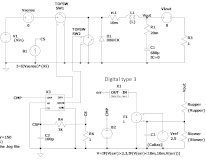
As this article explains, LTspice has multiple
features that help with the design of a
digital compensator. The author’s macro
automates generation of filter coefficients
for a type 3 compensator. |

|
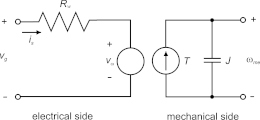
Basic PMS motor magnitude-control model
with torque-current analogy. Windings
are modeled by series resistance Rw and
induced-voltage source vω circuit
elements. J is rotor inertia. |
Motor Control For Designers (Part 4): PMS Motor Electrical Model
by Dennis Feucht, Innovatia Laboratories, Cayo, Belize
Previous articles have developed the design equations needed to create an electrical motor model. The resulting model, which will be presented here, is simplified as a magnitude-only model in that it assumes that the torque angle δ = π/2 = 90° — that phase control is field-oriented. This is not a major limitation from a design standpoint because magnitude and phase control are usually separate subsystems. (Later, this mini-course will cover phase control.) As noted in Motor Control For Designers (Part 1), the book cited by Krause and Wasynczuk develops a complete model that is taken apart in design for separate magnitude and phase control. This discussion begins with the introduction of a basic PMS motor model that represents the electrical and mechanical reference frames of the motor. Read the article…
|

Integrator Feedback Resistor — Adverse Or Friendly? How To DC Stabilize An Integrator Output
by Gregory Mirsky, Design Engineer, Deer Park, Ill.
The integrator design in a recent article was incomplete as it did not correct for the “walkaway” of the integrator output caused by thermal and noise effects at the amplifier’s inputs, which include input voltage offsets and leakage current. These stray parameters make the integrator inoperable if specific measures are not taken. Very often designers use a feedback resistor of a few megohms, establishing negative feedback to eliminate the integrator output walkaway. But does this method work and if so, what effects might it have on integrator operation? In this article, we analyze the impact of the dc feedback resistor on integrator design—both inverting and non-inverting. We also discuss another method of stabilizing integrator operation in the Rogowski sensor application with servo feedback. Read the article…
|
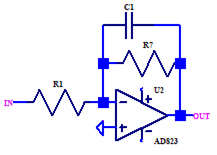
Utilizing a feedback resistor R7 eliminates
the output dc walkaway, but changes the
frequency response of the circuit. |


FOCUS ON MAGNETICS 
Sponsored by Payton Planar Magnetics
A monthly column presenting information on power magnetics design, products, or related technology |
Why Couple The Windings In A SEPIC?
by Eleazar Falco, Würth Elektronik, Waldenburg, Germany
The SEPIC (single-ended primary-inductor converter) is a nonisolated, switching power supply topology that provides an output voltage that can be higher, equal or lower than the input voltage. The SEPIC power stage is built with two inductors, which could also share the same magnetic core as the two windings of a coupled inductor. This approach provides some advantages compared to an uncoupled design, like a lower ripple current amplitude on each winding, and it is common to hear that either the required inductance or the ripple current can be “halved” thanks to the magnetic coupling. This article explains why the ripple current amplitude is reduced when magnetically coupling the windings in a SEPIC, as well as how the leakage inductance affects the maximum ripple current reduction. In addition, real measurements show that using a coupled inductor offers higher efficiency.
Read the article…
|

 |
 |

 |

|

INDUSTRY EVENT
 |
|
Vendors Line Up To Support NVIDIA’s 800-V Power Architecture For AI Data Centers
by David G. Morrison, Editor, How2Power.com
NVIDIA has been collaborating with a host of supplier companies to support migration of AI data centers to the 800-V power architecture starting in 2027. While some power semiconductor and power supply companies made announcements earlier this year in support of the 800-V dc architecture, the occurrence of the OCP Global Summit this October 13-16 in San Jose spurred an outpouring of such announcements as suppliers rushed to publicize their collaboration with NVIDIA and highlight their particular technology and product advantages. In many cases, vendors have also taken this opportunity to introduce white papers on the subject. This article is a recap of those announcements with some additional details gleaned from attending the summit. Read the full story…
|


POWER PRODUCTS  |

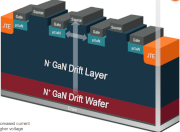
Onsemi’s vertical GaN devices. |
Chipmaker Samples 700-V And 1,200-V Vertical GaN Power Devices
 Drawing: A cross-sectional diagram depicting onsemi’s vertical GaN structure for an enhancement-mode JFET. The company’s vGaN technology is designed to handle high voltages in a monolithic die, while switching high currents at high frequency with superior efficiency. Drawing: A cross-sectional diagram depicting onsemi’s vertical GaN structure for an enhancement-mode JFET. The company’s vGaN technology is designed to handle high voltages in a monolithic die, while switching high currents at high frequency with superior efficiency.
See the full story…
|

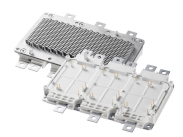
CISSOID’s CXT-PLA3BG07820RA
IGBT power module. |
IGBT And SiC Power Module Families Offer Performance And Flexibility
 Photo: “With this expansion, we’re giving system designers the freedom to select from a wider range of proven, robust power modules, while ensuring drop-in compatibility with their existing designs,” said Pierre Delatte, Chief Technology Officer at CISSOID. “The first product is a 750-V, 820-A automotive-qualified three-phase IGBT power module. Photo: “With this expansion, we’re giving system designers the freedom to select from a wider range of proven, robust power modules, while ensuring drop-in compatibility with their existing designs,” said Pierre Delatte, Chief Technology Officer at CISSOID. “The first product is a 750-V, 820-A automotive-qualified three-phase IGBT power module.
See the full story…
|



KYOCERA AVX’s KGP
series stacked capacitors. |
Stacked Capacitors Benefit Power Supply And Down-Hole Applications
 Photo: The commercial-grade stacked MLCCs are engineered to optimize the performance of high-frequency applications in the industrial, alternative energy, and downhole oil and gas industries. They deliver higher capacitance values in the same mounting area as traditional capacitors. Photo: The commercial-grade stacked MLCCs are engineered to optimize the performance of high-frequency applications in the industrial, alternative energy, and downhole oil and gas industries. They deliver higher capacitance values in the same mounting area as traditional capacitors.
See the full story…
|


|

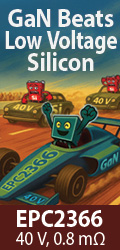



|

INDUSTRY EVENT  |
|
PwrSoC Completes Another Successful Workshop
by Jaeha Kim, General Chair and Jungik Ha, General Vice-Chair, PwrSoC 2025
The 9th International Workshop on Power Supply on Chip (PwrSoC) has just concluded. Held from September 24 to 26, 2025, in Seoul, South Korea, this year’s workshop marked another significant milestone in the field of integrated power solutions. Over 213 leading researchers and industry professionals from around the world gathered to share insights and advances in the miniaturization and integration of power conversion and power management at the chip, package, and module level. Read the full story…
|

NEW ON HOW2POWER.COM
 |
|
NSREC Notes: Advanced PWM Controllers, Power MOSFETs, Buck Converters And QML Parts Are Among The Latest Power Products For Space
This 11-page How2Power exclusive presents news of the latest rad-hard and rad-tolerant power components, reference designs, and power converters, and product development plans as presented at NSREC 2025 in Nashville. Read the full story…
|


OTHER TOP POWER NEWS
|
|
 Micross’ Hi-Rel Power Solutions team in Denmark has successfully delivered the first flight hardware from their new facility since its grand opening in March. Micross’ Hi-Rel Power Solutions team in Denmark has successfully delivered the first flight hardware from their new facility since its grand opening in March.
 Paper submission for ELECTRIMACS 2026 is now open. The conference will focus on modeling, simulation, control, and optimization of electrical systems. Paper submission for ELECTRIMACS 2026 is now open. The conference will focus on modeling, simulation, control, and optimization of electrical systems.
 Infineon Technologies’ CoolGaN bidirectional switch technology is enabling significant enhancements in power output, energy efficiency, and system reliability for Enphase Energy’s IQ9 series microinverters. Infineon Technologies’ CoolGaN bidirectional switch technology is enabling significant enhancements in power output, energy efficiency, and system reliability for Enphase Energy’s IQ9 series microinverters.
|



 The Center for Power Electronics Systems (CPES) is entering a new chapter of leadership, as Rolando Burgos steps down as center director and Richard Zhang becomes the new director. The Center for Power Electronics Systems (CPES) is entering a new chapter of leadership, as Rolando Burgos steps down as center director and Richard Zhang becomes the new director.
 Cambridge GaN Devices (CGD) is working with GlobalFoundries to expand the supply chain for CGD’s ICeGaN power devices. Cambridge GaN Devices (CGD) is working with GlobalFoundries to expand the supply chain for CGD’s ICeGaN power devices.
 onsemi has completed the acquisition of rights to Vcore power technologies including associated IP licenses from Aura Semiconductor. onsemi has completed the acquisition of rights to Vcore power technologies including associated IP licenses from Aura Semiconductor.



 Danisense, a provider of high-accuracy current sense transducers, has announced the acquisition of Polish winding company, Scanwinding. Danisense, a provider of high-accuracy current sense transducers, has announced the acquisition of Polish winding company, Scanwinding.
 Century Lithium’s Demonstration Plant in Amargosa Valley, Nevada has produced lithium hydroxide from lithium carbonate derived from the company's Angel Island lithium project. Century Lithium’s Demonstration Plant in Amargosa Valley, Nevada has produced lithium hydroxide from lithium carbonate derived from the company's Angel Island lithium project.
 Infineon has signed agreements to purchase long-term green electricity from wind farms in Brandenburg, Germany and solar plants in Spain. Infineon has signed agreements to purchase long-term green electricity from wind farms in Brandenburg, Germany and solar plants in Spain.

ABOUT THIS NEWSLETTER: Thank you for reading HOW2POWER TODAY.
How2Power sends no more than one e-mail per month to registered users. Continuing your subscription ensures you'll receive future newsletters. Manage Your Subscription
©2020 All rights reserved. www.how2power.com
|
|